Sports Branding and Sponsorship: A Comprehensive Overview
VerifiedAdded on 2023/01/04
|7
|1779
|94
Report
AI Summary
This report delves into the multifaceted world of sports branding and sponsorship, exploring the crucial link between brand image and athletes. It defines sports branding as the creation of a recognizable brand associated with a sport or organization, highlighting the growing importance of branding in the sports market. The report examines the concept of "brand religion" and brand loyalty, using examples like Manchester United and Barcelona to illustrate successful branding strategies. It emphasizes the direct relationship between an athlete's performance and their brand image, citing Virat Kohli, Christiano Ronaldo, and others as examples. Furthermore, the report details five distinct types of sports sponsorship: title, main, official, official partner, and technical partners, providing examples for each. The report utilizes various academic sources to support its findings, offering a comprehensive overview of sports branding and sponsorship strategies.
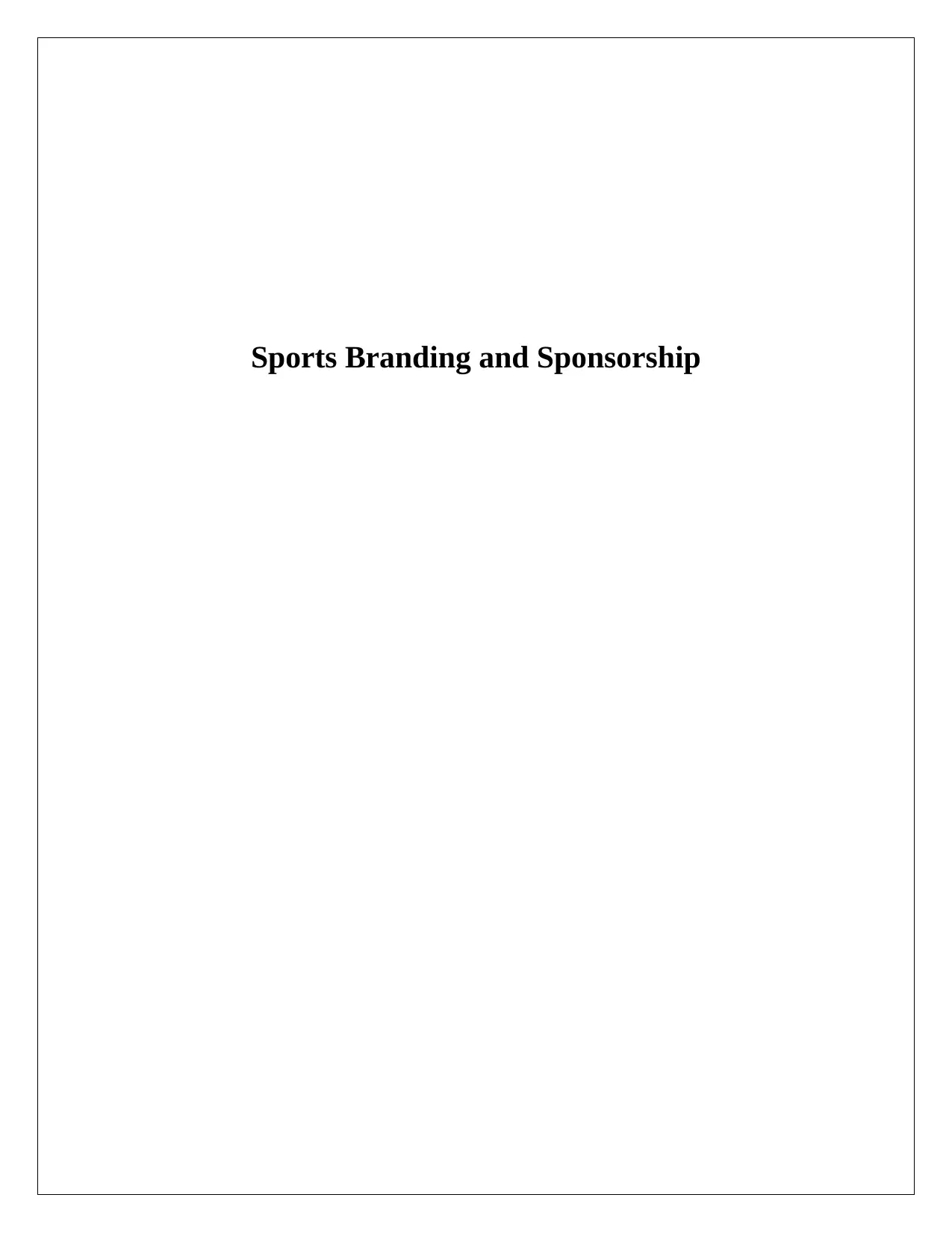
Sports Branding and Sponsorship
Paraphrase This Document
Need a fresh take? Get an instant paraphrase of this document with our AI Paraphraser
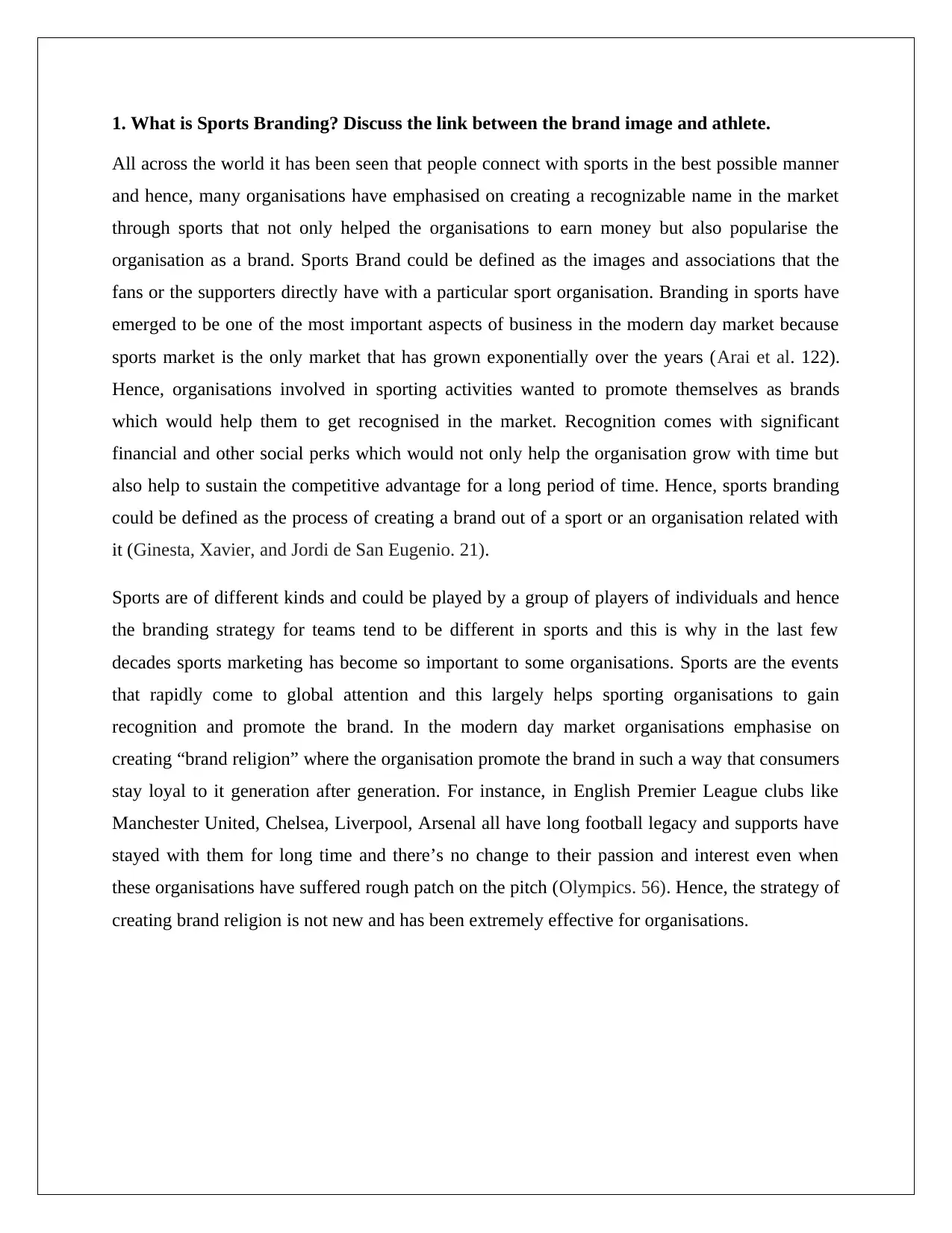
1. What is Sports Branding? Discuss the link between the brand image and athlete.
All across the world it has been seen that people connect with sports in the best possible manner
and hence, many organisations have emphasised on creating a recognizable name in the market
through sports that not only helped the organisations to earn money but also popularise the
organisation as a brand. Sports Brand could be defined as the images and associations that the
fans or the supporters directly have with a particular sport organisation. Branding in sports have
emerged to be one of the most important aspects of business in the modern day market because
sports market is the only market that has grown exponentially over the years (Arai et al. 122).
Hence, organisations involved in sporting activities wanted to promote themselves as brands
which would help them to get recognised in the market. Recognition comes with significant
financial and other social perks which would not only help the organisation grow with time but
also help to sustain the competitive advantage for a long period of time. Hence, sports branding
could be defined as the process of creating a brand out of a sport or an organisation related with
it (Ginesta, Xavier, and Jordi de San Eugenio. 21).
Sports are of different kinds and could be played by a group of players of individuals and hence
the branding strategy for teams tend to be different in sports and this is why in the last few
decades sports marketing has become so important to some organisations. Sports are the events
that rapidly come to global attention and this largely helps sporting organisations to gain
recognition and promote the brand. In the modern day market organisations emphasise on
creating “brand religion” where the organisation promote the brand in such a way that consumers
stay loyal to it generation after generation. For instance, in English Premier League clubs like
Manchester United, Chelsea, Liverpool, Arsenal all have long football legacy and supports have
stayed with them for long time and there’s no change to their passion and interest even when
these organisations have suffered rough patch on the pitch (Olympics. 56). Hence, the strategy of
creating brand religion is not new and has been extremely effective for organisations.
All across the world it has been seen that people connect with sports in the best possible manner
and hence, many organisations have emphasised on creating a recognizable name in the market
through sports that not only helped the organisations to earn money but also popularise the
organisation as a brand. Sports Brand could be defined as the images and associations that the
fans or the supporters directly have with a particular sport organisation. Branding in sports have
emerged to be one of the most important aspects of business in the modern day market because
sports market is the only market that has grown exponentially over the years (Arai et al. 122).
Hence, organisations involved in sporting activities wanted to promote themselves as brands
which would help them to get recognised in the market. Recognition comes with significant
financial and other social perks which would not only help the organisation grow with time but
also help to sustain the competitive advantage for a long period of time. Hence, sports branding
could be defined as the process of creating a brand out of a sport or an organisation related with
it (Ginesta, Xavier, and Jordi de San Eugenio. 21).
Sports are of different kinds and could be played by a group of players of individuals and hence
the branding strategy for teams tend to be different in sports and this is why in the last few
decades sports marketing has become so important to some organisations. Sports are the events
that rapidly come to global attention and this largely helps sporting organisations to gain
recognition and promote the brand. In the modern day market organisations emphasise on
creating “brand religion” where the organisation promote the brand in such a way that consumers
stay loyal to it generation after generation. For instance, in English Premier League clubs like
Manchester United, Chelsea, Liverpool, Arsenal all have long football legacy and supports have
stayed with them for long time and there’s no change to their passion and interest even when
these organisations have suffered rough patch on the pitch (Olympics. 56). Hence, the strategy of
creating brand religion is not new and has been extremely effective for organisations.
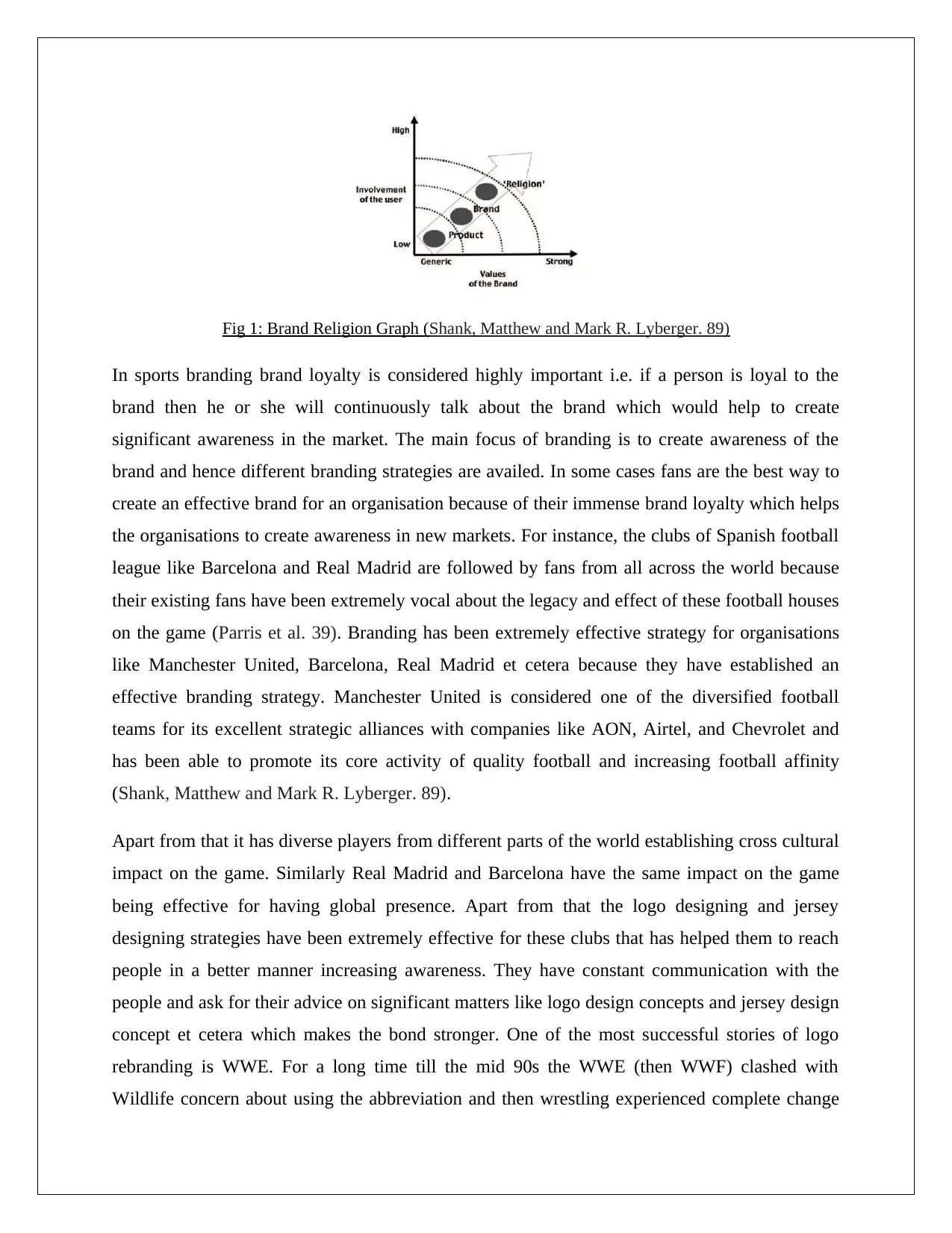
Fig 1: Brand Religion Graph (Shank, Matthew and Mark R. Lyberger. 89)
In sports branding brand loyalty is considered highly important i.e. if a person is loyal to the
brand then he or she will continuously talk about the brand which would help to create
significant awareness in the market. The main focus of branding is to create awareness of the
brand and hence different branding strategies are availed. In some cases fans are the best way to
create an effective brand for an organisation because of their immense brand loyalty which helps
the organisations to create awareness in new markets. For instance, the clubs of Spanish football
league like Barcelona and Real Madrid are followed by fans from all across the world because
their existing fans have been extremely vocal about the legacy and effect of these football houses
on the game (Parris et al. 39). Branding has been extremely effective strategy for organisations
like Manchester United, Barcelona, Real Madrid et cetera because they have established an
effective branding strategy. Manchester United is considered one of the diversified football
teams for its excellent strategic alliances with companies like AON, Airtel, and Chevrolet and
has been able to promote its core activity of quality football and increasing football affinity
(Shank, Matthew and Mark R. Lyberger. 89).
Apart from that it has diverse players from different parts of the world establishing cross cultural
impact on the game. Similarly Real Madrid and Barcelona have the same impact on the game
being effective for having global presence. Apart from that the logo designing and jersey
designing strategies have been extremely effective for these clubs that has helped them to reach
people in a better manner increasing awareness. They have constant communication with the
people and ask for their advice on significant matters like logo design concepts and jersey design
concept et cetera which makes the bond stronger. One of the most successful stories of logo
rebranding is WWE. For a long time till the mid 90s the WWE (then WWF) clashed with
Wildlife concern about using the abbreviation and then wrestling experienced complete change
In sports branding brand loyalty is considered highly important i.e. if a person is loyal to the
brand then he or she will continuously talk about the brand which would help to create
significant awareness in the market. The main focus of branding is to create awareness of the
brand and hence different branding strategies are availed. In some cases fans are the best way to
create an effective brand for an organisation because of their immense brand loyalty which helps
the organisations to create awareness in new markets. For instance, the clubs of Spanish football
league like Barcelona and Real Madrid are followed by fans from all across the world because
their existing fans have been extremely vocal about the legacy and effect of these football houses
on the game (Parris et al. 39). Branding has been extremely effective strategy for organisations
like Manchester United, Barcelona, Real Madrid et cetera because they have established an
effective branding strategy. Manchester United is considered one of the diversified football
teams for its excellent strategic alliances with companies like AON, Airtel, and Chevrolet and
has been able to promote its core activity of quality football and increasing football affinity
(Shank, Matthew and Mark R. Lyberger. 89).
Apart from that it has diverse players from different parts of the world establishing cross cultural
impact on the game. Similarly Real Madrid and Barcelona have the same impact on the game
being effective for having global presence. Apart from that the logo designing and jersey
designing strategies have been extremely effective for these clubs that has helped them to reach
people in a better manner increasing awareness. They have constant communication with the
people and ask for their advice on significant matters like logo design concepts and jersey design
concept et cetera which makes the bond stronger. One of the most successful stories of logo
rebranding is WWE. For a long time till the mid 90s the WWE (then WWF) clashed with
Wildlife concern about using the abbreviation and then wrestling experienced complete change
⊘ This is a preview!⊘
Do you want full access?
Subscribe today to unlock all pages.

Trusted by 1+ million students worldwide
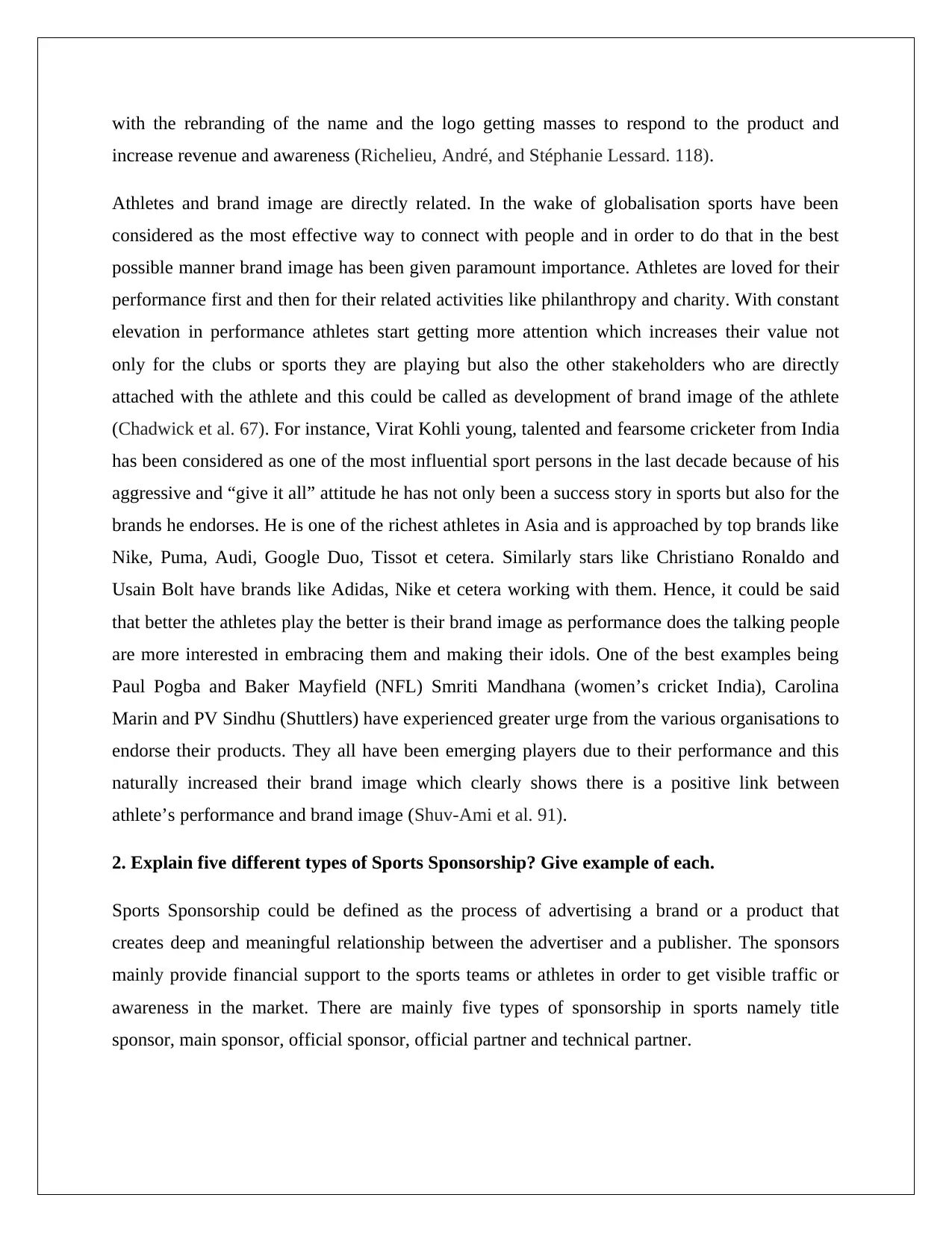
with the rebranding of the name and the logo getting masses to respond to the product and
increase revenue and awareness (Richelieu, André, and Stéphanie Lessard. 118).
Athletes and brand image are directly related. In the wake of globalisation sports have been
considered as the most effective way to connect with people and in order to do that in the best
possible manner brand image has been given paramount importance. Athletes are loved for their
performance first and then for their related activities like philanthropy and charity. With constant
elevation in performance athletes start getting more attention which increases their value not
only for the clubs or sports they are playing but also the other stakeholders who are directly
attached with the athlete and this could be called as development of brand image of the athlete
(Chadwick et al. 67). For instance, Virat Kohli young, talented and fearsome cricketer from India
has been considered as one of the most influential sport persons in the last decade because of his
aggressive and “give it all” attitude he has not only been a success story in sports but also for the
brands he endorses. He is one of the richest athletes in Asia and is approached by top brands like
Nike, Puma, Audi, Google Duo, Tissot et cetera. Similarly stars like Christiano Ronaldo and
Usain Bolt have brands like Adidas, Nike et cetera working with them. Hence, it could be said
that better the athletes play the better is their brand image as performance does the talking people
are more interested in embracing them and making their idols. One of the best examples being
Paul Pogba and Baker Mayfield (NFL) Smriti Mandhana (women’s cricket India), Carolina
Marin and PV Sindhu (Shuttlers) have experienced greater urge from the various organisations to
endorse their products. They all have been emerging players due to their performance and this
naturally increased their brand image which clearly shows there is a positive link between
athlete’s performance and brand image (Shuv-Ami et al. 91).
2. Explain five different types of Sports Sponsorship? Give example of each.
Sports Sponsorship could be defined as the process of advertising a brand or a product that
creates deep and meaningful relationship between the advertiser and a publisher. The sponsors
mainly provide financial support to the sports teams or athletes in order to get visible traffic or
awareness in the market. There are mainly five types of sponsorship in sports namely title
sponsor, main sponsor, official sponsor, official partner and technical partner.
increase revenue and awareness (Richelieu, André, and Stéphanie Lessard. 118).
Athletes and brand image are directly related. In the wake of globalisation sports have been
considered as the most effective way to connect with people and in order to do that in the best
possible manner brand image has been given paramount importance. Athletes are loved for their
performance first and then for their related activities like philanthropy and charity. With constant
elevation in performance athletes start getting more attention which increases their value not
only for the clubs or sports they are playing but also the other stakeholders who are directly
attached with the athlete and this could be called as development of brand image of the athlete
(Chadwick et al. 67). For instance, Virat Kohli young, talented and fearsome cricketer from India
has been considered as one of the most influential sport persons in the last decade because of his
aggressive and “give it all” attitude he has not only been a success story in sports but also for the
brands he endorses. He is one of the richest athletes in Asia and is approached by top brands like
Nike, Puma, Audi, Google Duo, Tissot et cetera. Similarly stars like Christiano Ronaldo and
Usain Bolt have brands like Adidas, Nike et cetera working with them. Hence, it could be said
that better the athletes play the better is their brand image as performance does the talking people
are more interested in embracing them and making their idols. One of the best examples being
Paul Pogba and Baker Mayfield (NFL) Smriti Mandhana (women’s cricket India), Carolina
Marin and PV Sindhu (Shuttlers) have experienced greater urge from the various organisations to
endorse their products. They all have been emerging players due to their performance and this
naturally increased their brand image which clearly shows there is a positive link between
athlete’s performance and brand image (Shuv-Ami et al. 91).
2. Explain five different types of Sports Sponsorship? Give example of each.
Sports Sponsorship could be defined as the process of advertising a brand or a product that
creates deep and meaningful relationship between the advertiser and a publisher. The sponsors
mainly provide financial support to the sports teams or athletes in order to get visible traffic or
awareness in the market. There are mainly five types of sponsorship in sports namely title
sponsor, main sponsor, official sponsor, official partner and technical partner.
Paraphrase This Document
Need a fresh take? Get an instant paraphrase of this document with our AI Paraphraser
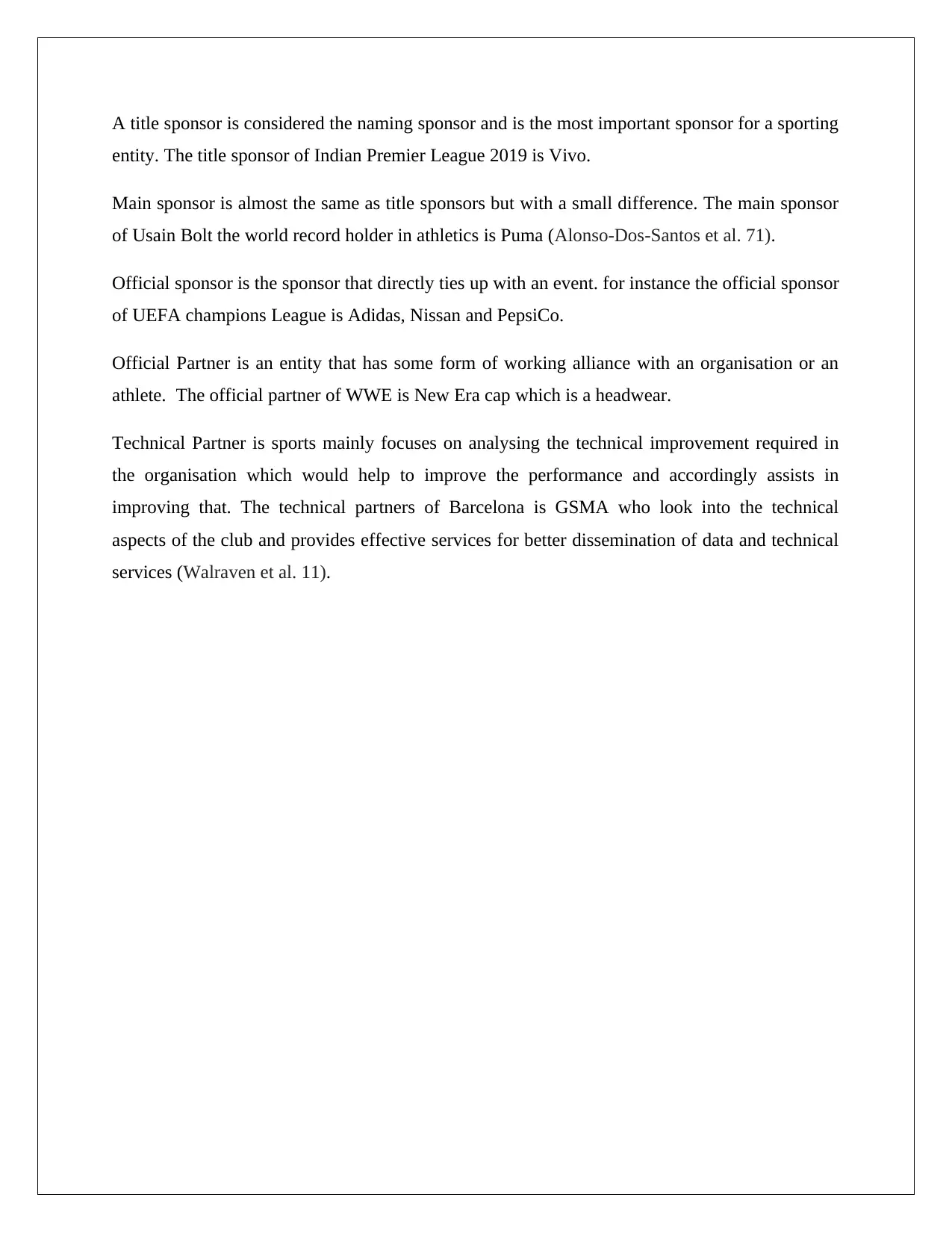
A title sponsor is considered the naming sponsor and is the most important sponsor for a sporting
entity. The title sponsor of Indian Premier League 2019 is Vivo.
Main sponsor is almost the same as title sponsors but with a small difference. The main sponsor
of Usain Bolt the world record holder in athletics is Puma (Alonso-Dos-Santos et al. 71).
Official sponsor is the sponsor that directly ties up with an event. for instance the official sponsor
of UEFA champions League is Adidas, Nissan and PepsiCo.
Official Partner is an entity that has some form of working alliance with an organisation or an
athlete. The official partner of WWE is New Era cap which is a headwear.
Technical Partner is sports mainly focuses on analysing the technical improvement required in
the organisation which would help to improve the performance and accordingly assists in
improving that. The technical partners of Barcelona is GSMA who look into the technical
aspects of the club and provides effective services for better dissemination of data and technical
services (Walraven et al. 11).
entity. The title sponsor of Indian Premier League 2019 is Vivo.
Main sponsor is almost the same as title sponsors but with a small difference. The main sponsor
of Usain Bolt the world record holder in athletics is Puma (Alonso-Dos-Santos et al. 71).
Official sponsor is the sponsor that directly ties up with an event. for instance the official sponsor
of UEFA champions League is Adidas, Nissan and PepsiCo.
Official Partner is an entity that has some form of working alliance with an organisation or an
athlete. The official partner of WWE is New Era cap which is a headwear.
Technical Partner is sports mainly focuses on analysing the technical improvement required in
the organisation which would help to improve the performance and accordingly assists in
improving that. The technical partners of Barcelona is GSMA who look into the technical
aspects of the club and provides effective services for better dissemination of data and technical
services (Walraven et al. 11).
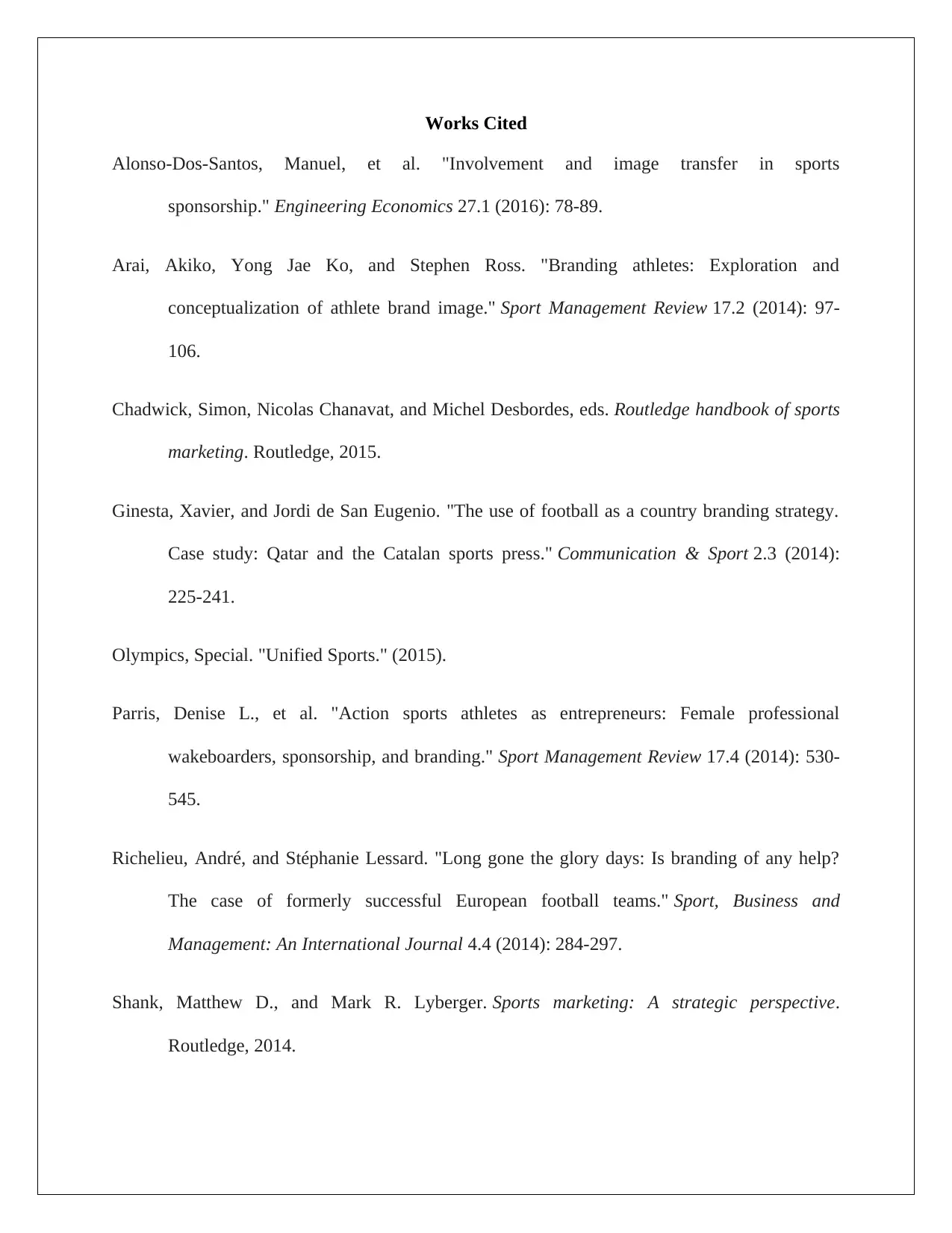
Works Cited
Alonso-Dos-Santos, Manuel, et al. "Involvement and image transfer in sports
sponsorship." Engineering Economics 27.1 (2016): 78-89.
Arai, Akiko, Yong Jae Ko, and Stephen Ross. "Branding athletes: Exploration and
conceptualization of athlete brand image." Sport Management Review 17.2 (2014): 97-
106.
Chadwick, Simon, Nicolas Chanavat, and Michel Desbordes, eds. Routledge handbook of sports
marketing. Routledge, 2015.
Ginesta, Xavier, and Jordi de San Eugenio. "The use of football as a country branding strategy.
Case study: Qatar and the Catalan sports press." Communication & Sport 2.3 (2014):
225-241.
Olympics, Special. "Unified Sports." (2015).
Parris, Denise L., et al. "Action sports athletes as entrepreneurs: Female professional
wakeboarders, sponsorship, and branding." Sport Management Review 17.4 (2014): 530-
545.
Richelieu, André, and Stéphanie Lessard. "Long gone the glory days: Is branding of any help?
The case of formerly successful European football teams." Sport, Business and
Management: An International Journal 4.4 (2014): 284-297.
Shank, Matthew D., and Mark R. Lyberger. Sports marketing: A strategic perspective.
Routledge, 2014.
Alonso-Dos-Santos, Manuel, et al. "Involvement and image transfer in sports
sponsorship." Engineering Economics 27.1 (2016): 78-89.
Arai, Akiko, Yong Jae Ko, and Stephen Ross. "Branding athletes: Exploration and
conceptualization of athlete brand image." Sport Management Review 17.2 (2014): 97-
106.
Chadwick, Simon, Nicolas Chanavat, and Michel Desbordes, eds. Routledge handbook of sports
marketing. Routledge, 2015.
Ginesta, Xavier, and Jordi de San Eugenio. "The use of football as a country branding strategy.
Case study: Qatar and the Catalan sports press." Communication & Sport 2.3 (2014):
225-241.
Olympics, Special. "Unified Sports." (2015).
Parris, Denise L., et al. "Action sports athletes as entrepreneurs: Female professional
wakeboarders, sponsorship, and branding." Sport Management Review 17.4 (2014): 530-
545.
Richelieu, André, and Stéphanie Lessard. "Long gone the glory days: Is branding of any help?
The case of formerly successful European football teams." Sport, Business and
Management: An International Journal 4.4 (2014): 284-297.
Shank, Matthew D., and Mark R. Lyberger. Sports marketing: A strategic perspective.
Routledge, 2014.
⊘ This is a preview!⊘
Do you want full access?
Subscribe today to unlock all pages.

Trusted by 1+ million students worldwide
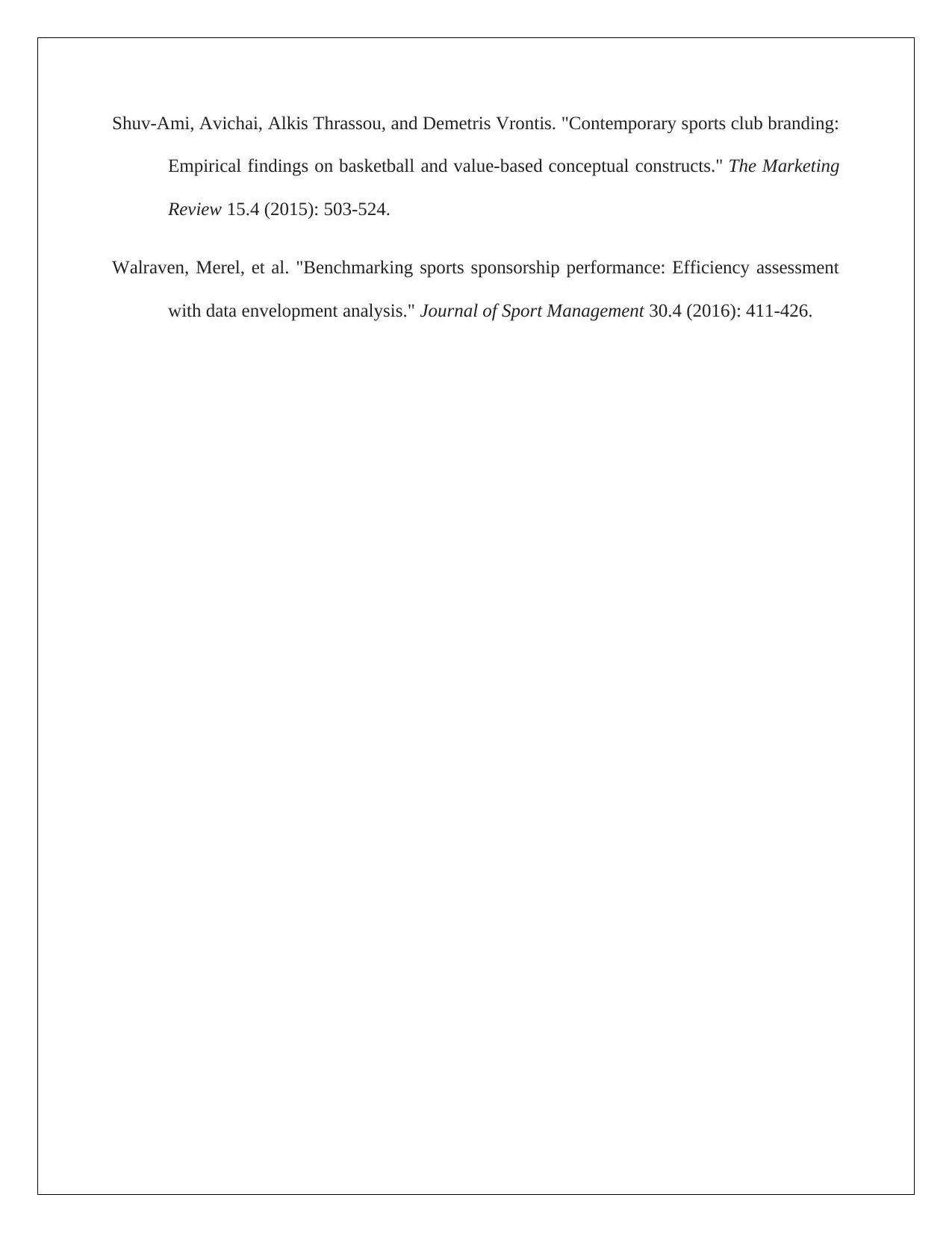
Shuv-Ami, Avichai, Alkis Thrassou, and Demetris Vrontis. "Contemporary sports club branding:
Empirical findings on basketball and value-based conceptual constructs." The Marketing
Review 15.4 (2015): 503-524.
Walraven, Merel, et al. "Benchmarking sports sponsorship performance: Efficiency assessment
with data envelopment analysis." Journal of Sport Management 30.4 (2016): 411-426.
Empirical findings on basketball and value-based conceptual constructs." The Marketing
Review 15.4 (2015): 503-524.
Walraven, Merel, et al. "Benchmarking sports sponsorship performance: Efficiency assessment
with data envelopment analysis." Journal of Sport Management 30.4 (2016): 411-426.
1 out of 7
Related Documents
Your All-in-One AI-Powered Toolkit for Academic Success.
+13062052269
info@desklib.com
Available 24*7 on WhatsApp / Email
![[object Object]](/_next/static/media/star-bottom.7253800d.svg)
Unlock your academic potential
Copyright © 2020–2025 A2Z Services. All Rights Reserved. Developed and managed by ZUCOL.





